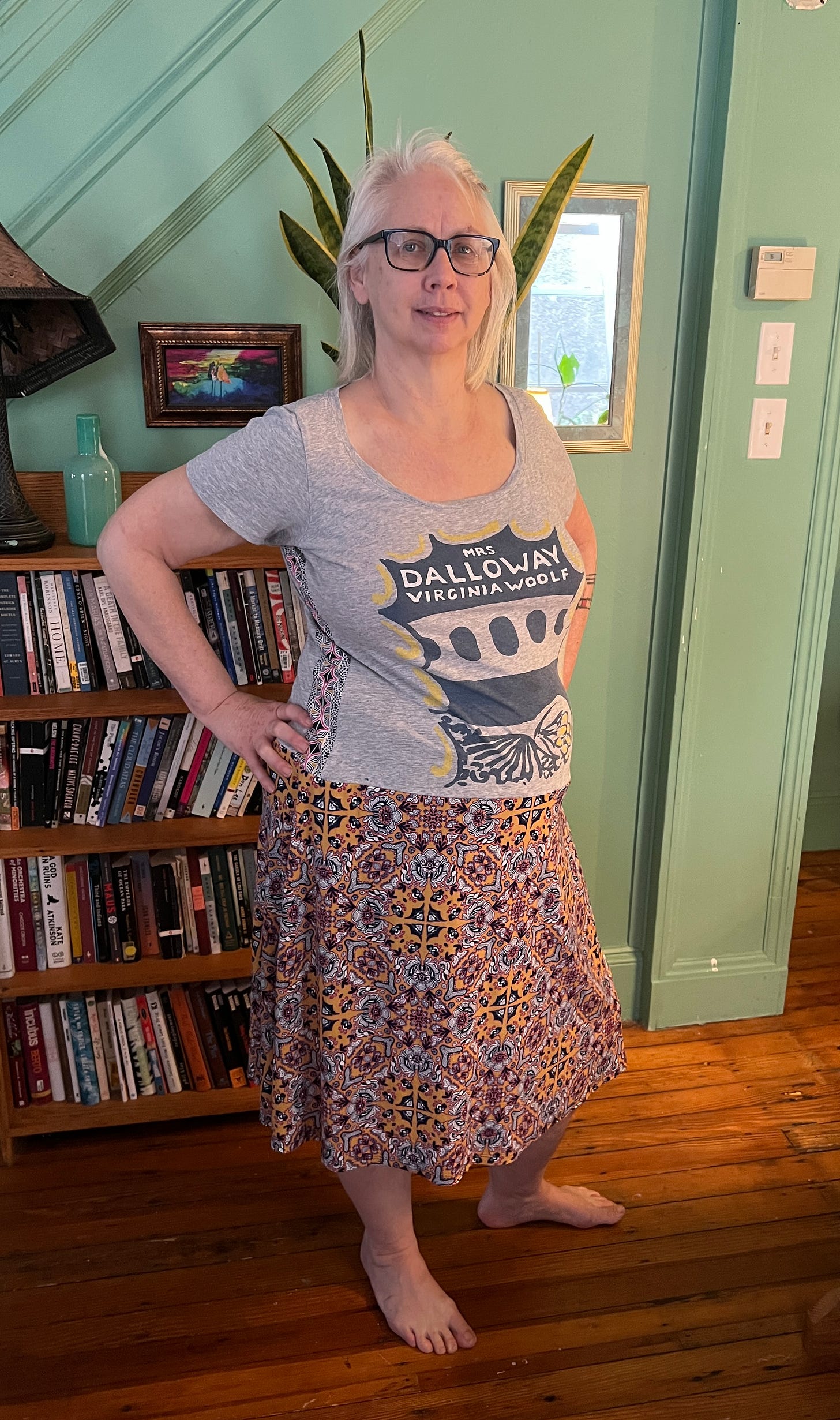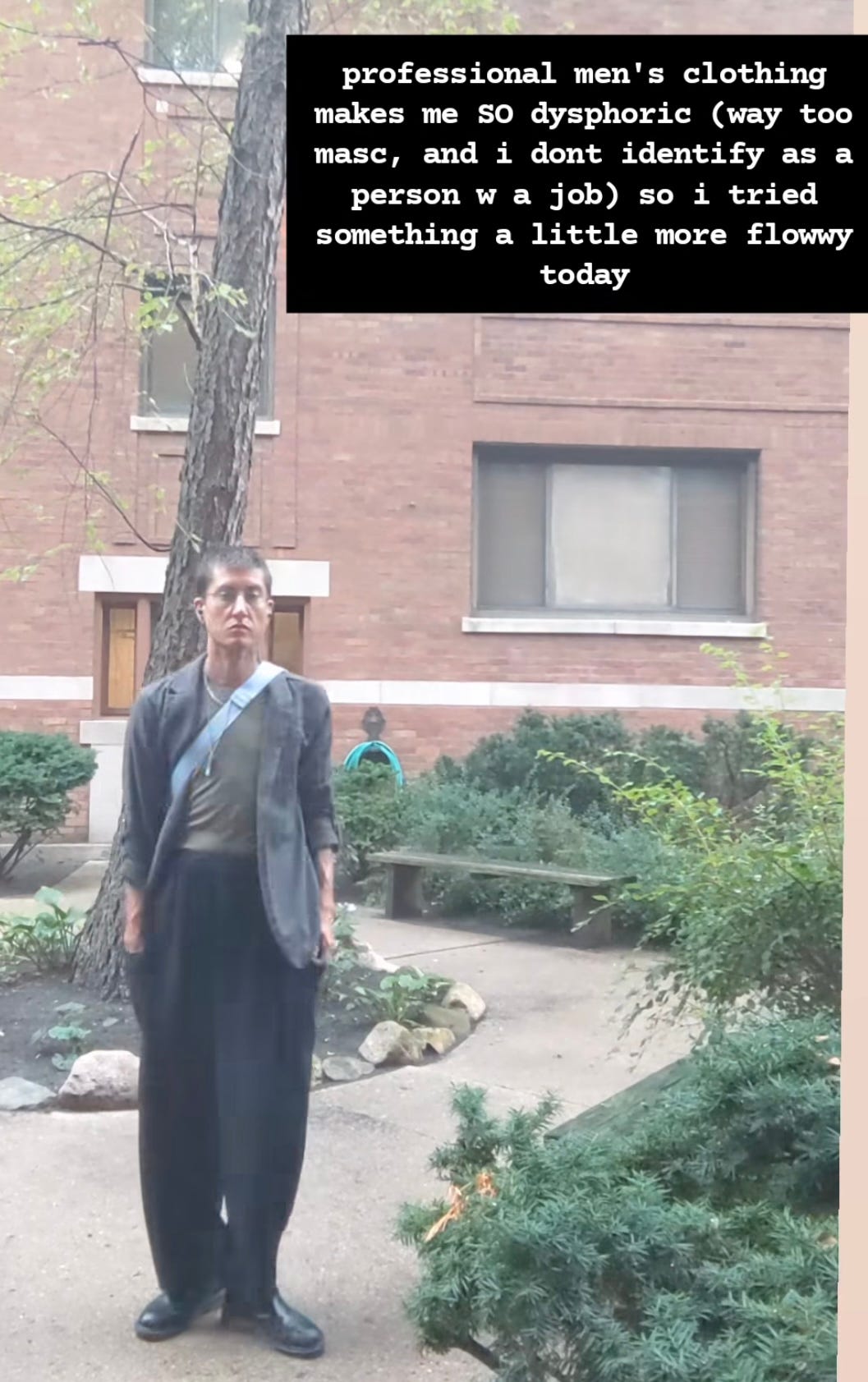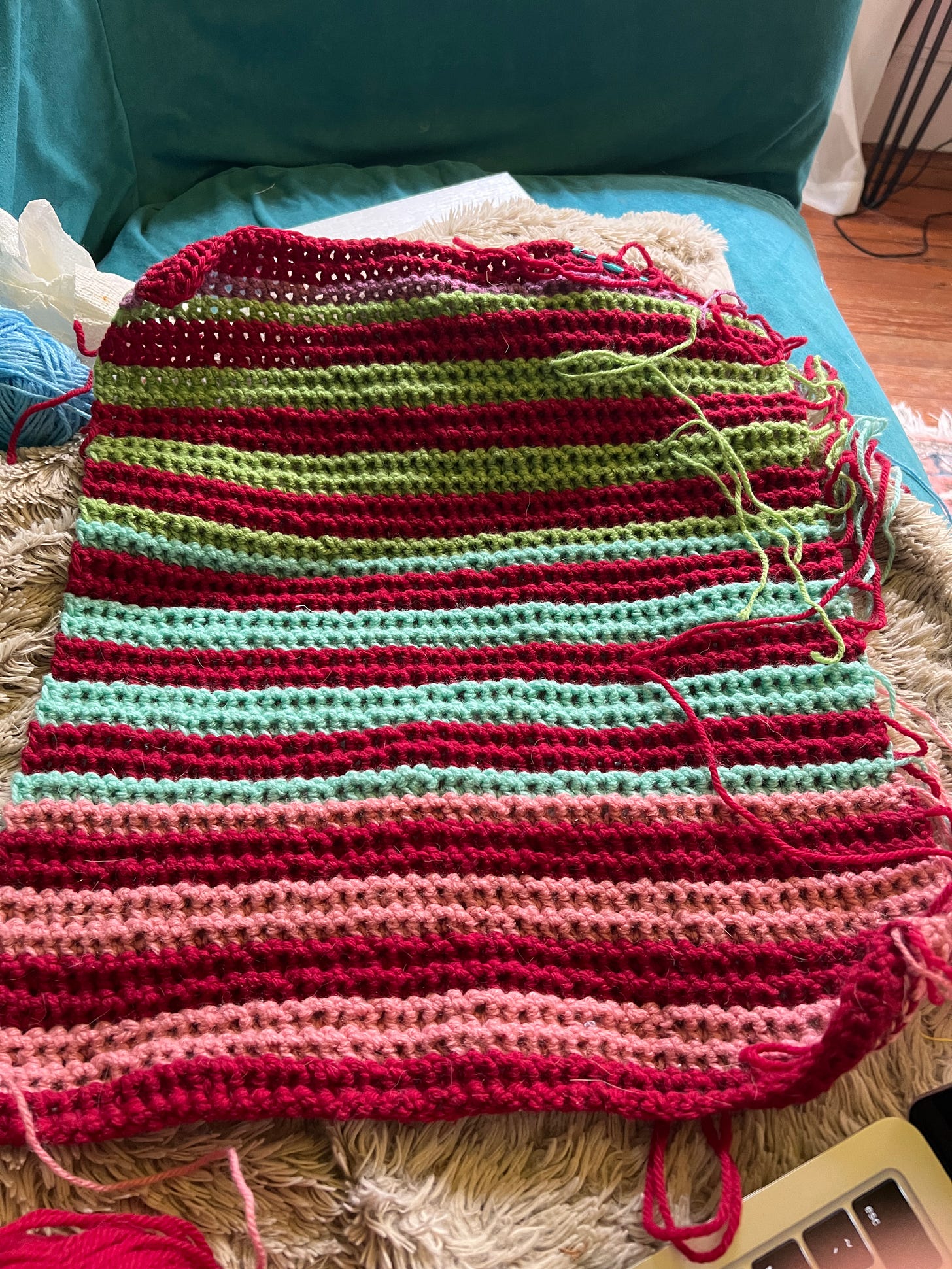The Neuroqueer Case for Learning to Sew
on waking from the fever dream of a new special interest
Sign up for a FREE taster session (including recording) for the third cohort of Neuroqueering Your Creative Practice, starting in September, or join the interest list for exclusive access to discounted Early Bird tickets, going on sale soon!
Having a new special interest is a lot like a love affair.
I don’t mean a casual, oh-this-is-kind-of-interesting-I-might-watch-a-few-YouTube-videos-in-my-spare time sort of special interest. That’s perhaps more like making a new acquaintance who seems really interesting and you hope might become a friend.
I’m talking about an obsessive, the-rest-of-my-life-is-going-to-hell-in-a-handbasket-and-I’m-being-completely-irresponsible-but-I-just-don’t-care sort of special interest. All I want is to be with my beloved, and the real world be damned.
This is how it has been for me this spring and summer with sewing and crochet. And while the acquaintance-who-might-become-a-friend sort of special interest may be a dime a dozen, I feel like this sort of epic love affair of a special interest doesn’t come along every day. How often in a lifetime do we get to feel like that? Often in the past I would have resisted the temptation, feeling virtuous and responsible, or I would have let myself succumb to shame and broken up with my beloved before things got too deep.
But in this phase of my life, at least, I’m throwing caution to the wind. None of us knows how much longer we have, but I’m a lot older than most of you (I turn 60 next month!) and so I mostly likely have less time left. To me, this doesn’t feel like a morbid thought at all. It’s actually really comforting—the constraints of age, like so many constraints in art, can be very freeing.
This doesn’t mean that my new love affair has been without its doubts and anxieties. As with any love affair, it’s impossible (for me at least) to become completely unaware of the routines and responsibilities I am chucking out the window in favor of my new beloved. My house is a pig stye, and while I generally don’t aspire to a high level of tidiness and cleanliness, when it gets this bad it does start to overstimulate my nervous system, and even send me into shame spirals. And just in general, the feeling that I’m not doing what I’m “supposed” to be doing, and that I’m being irresponsible, has felt sort of like an irritating swarm of gnats I can’t swat away fast enough. The miserable heat we’ve been experiencing this summer in Philadelphia hasn’t helped.
Another casualty, as anyone who is paying attention to my recent publication schedule will have notice is writing. Until just the past few days, the well had run completely dry, and as a consequence, I’ve been away from The Spiral Lab for far too long. Because this newsletter is a significant part of my bread and butter, my inability to write anything for many weeks now has caused me considerable anxiety. I have pondered how I can fit my new passion into what I write about here, but I have worried that people who have come to expect a certain sort of content from me will be at best uninterested, and at worse, will actively dislike my new beloved.
Of course, everything is connected. One of the beauties of fiber arts is that the doing of them affords long stretches of time and meditative silence to ponder and dream and begin to see broader webs of interconnections. I have begun to see some clear connections to neuroqueerness, and, doubts and anxieties aside, I would now like to suggest that perhaps you might want to consider learning to sew!
Why?
Learning to Sew is Sensory Freedom.
I first started sewing with one specific goal in mind: I wanted to upcycle some of my old clothes to fit me better as my body size and shape has been changing. I didn’t want to, nor could I afford, to buy a bunch of new clothes that might not fit as my body continues to fluctuate (as it always does). I had some stretch pants that were a bit too tight around the waistband, and some t-shirts and dresses that were just a bit snug. So I set about learning how to make them work.
One t-shirt in particular, a reproduction of the cover of the novel Mrs. Dalloway by Virginia Woolf, had always been a bit small. I have a LOT of very specific sensory needs when it comes to clothes, and t-shirts specifically can be really tricky. If they are too tight, and especially if they are too short and ride up my belly, I Can. Not. Stand. It. But also, if they are too large and floppy, that is also intolerable. So I determined to learn how to size up a t-shirt, and along the way, I decided to combine it with a dress that I thought was really beautiful but that had several sensory problems of its own: the band around the middle was too tight (I can’t stand anything tight around my middle, more on that later), and the fabric was very synthetic, which felt ok on the skirt part but I really didn’t like against the skin of my torso. So I used part of the decorative trim from the dress to enlarge the t-shirt, and then added the skirt to the bottom so the t-shirt never rides up. This was my very first project, and it has combined two garments I loved but never wore, into one that I love and wear all the time.

I was hooked, and wanted to make more. I had started following two sewists on YouTube, Carly from Australia and Scarlett from Liverpool, and just loved their colorful, maximalist patchworked clothing. But Carly and Scarlett are both cool, sparkly young women, whereas I often feel dowdy and middle-aged. When I confessed to my friends on DDS my anxiety that the sort of garments Carly and Scarlett make would be ridiculous and age-inappropriate, they gave me exactly the sort of advice I would normally have given myself, if I weren’t, you know, my Self. The sort of advice I would give anyone else: WHO CARES?? They not only encouraged me to make myself something whimsical and girly (more on that later too), but basically demanded it.
In the spirit of both Carly and Scarlett, who use almost exclusively scrap and second-hand fabric, I sorted through Joel’s closet and absconded (with his permission of course) with all of the button down shirts he never wears. I didn’t feel up to making a bodice on my own yet, but I altered one of his shirts to fit me better, and then used the other shirts, plus some old sheets and pillow cases, to make a flowy twirly dress that I absolutely LOVE. It is a sensory dream and I think it is so pretty. And it cost $0.
Learning to Sew Can Also Offer Freedom of Gender Expression.
Recently, I made one of my rare appearances on Instagram and saw this story from my friend
Price:
My first thought, probably not entirely accurate but increasingly so, was “I could make that.” Certainly the flowy pants wouldn’t be too hard, especially if they don’t have a zipper fly (I think they might have, but I can’t tell for sure). This photo and Devon’s comments about clothing and gender dysphoria set me down an entirely new rabbit hole of contemplation.
For many of us, gender, style, and sensory needs are all very much connected. Sometimes our preferred gender expression in clothing seems not possible on account of our extreme sensory sensitivities. For example, I have long thought that if I didn’t have any sensory issues with clothing (can you imagine??), I would actually prefer a far more masc/androgynous style: fitted button down shirts, cropped blazers, narrow pants, big clunky boots. Alas, these sorts of clothes are simply not possible for me to wear for more than a few miserable hours. Instead I have always worn—long before I really understood why—a uniform of low-waisted stretch pants with really wide loose elastic, empire-waisted dresses, cardigan sweaters, and Birkenstocks or Dansco clogs that can easily be slipped on and off.
It’s not exactly that I dislike this uniform, even aesthetically—I very much enjoy flowy pretty dresses. But this has literally been all I wear, for decades, and it has always felt like it traps me in a very specific, and not entirely correct, gender expression. I don’t feel that femmy all the time, and I have long wished there were a way for me to mix up my wardrobe’s gender-expression without creating a sensory nightmare.
To be clear, this is more of a wish, not a need. I don’t experience gender dysphoria about my clothes or my body. But I definitely would feel more deeply like myself if I had a broader range of gender expression in my clothing.
Enter my sewing passion: one of the main things that learning to sew my own clothes has done is to teach me so much more about the actual shape of my body, and why certain cuts of clothing feel good and others feel intolerable.
For example, I have never been able to tolerate clothing that in any way cynches around my waist. High waisted pants, tights, skirts, dresses with a waist band or belt—all out. Or so I thought. But what I have come to understand is that these sorts of off-the-rack, waist-cynching garments aren’t actually coming to my natural waist, because my natural waist is exceptionally high. It is literally just under my rib cage, not across my belly-button as I had always thought (I literally shudder when I think of something wrapping around my torso at my belly-button). Off-the-rack clothing of these types is never going to work on my body, given my sensory sensitivities.
But now I understand where my natural waist is and where I can tolerate things being a bit more fitted. I also have come to understand that self-drafting patterns, or manipulating commercial patterns, is not the impossibly complicated realm of advanced sewists. This isn’t my first foray into sewing and other fabric arts—decades ago I made halloween costumes for my kids, and a few knitted sweaters—but it is my first effort with the assistance of a wealth of YouTube sewing channels and tutorials. As is true with almost any niche, I think, there are so many sewists on YouTube, making amazing and accessible content. In the course of just a few months, I now have the understanding and confidence to self-draft and alter patterns and clothing myself. It’s a lot of trial and error, but part of the fun is that mistakes no longer feel like a frustrating set-back, but rather an aha! moment and learning opportunity. My seam ripper is one of my favorite tools, and I actually find unpicking seams very meditative.
More and more I am coming to understand that the gender expression I would like to convey through my clothes is not either-or, or even androgynous, but rather a whimsical combination of traditionally gendered clothing. I am dreaming up mens-wear shaped bodices with big flowy skirts underneath. I have found indie pattern-makers coming up with ingenious solutions to the discomfort for many of us of traditional trousers—such as these clever Magic Pants created by the pattern-maker and sewist Ann Tilley, which have a very clever construction that looks fitted around the waist, but is really mostly fitted around the hips (heaven!) I haven’t made them yet, but I am excited to.
Learning to Sew Can Create More Size Inclusivity.
As I mentioned earlier, the reason I began sewing again this spring is because I had gained weight but couldn’t—and didn’t want to—buy all new clothing. My original idea was that I would just upcycle the clothing I have to make it fit better. But as I have been diving deeper and deeper into the community of sewists and indie pattern makers on YouTube, I have discovered that many of them are committed to size inclusivity. Unlike many mainstream pattern makers (if any remain after private equity has driven them out of business, another story entirely), many indie pattern makers have a much wider range of sizes, and they truly size them up, rather than just making a size 2 exponentially bigger in all directions, which is not how human bodies get bigger. Other patterns, such as Anne Tilly’s magic pants, very cleverly build size-adjustability into one garment. Another example of this is the split-side skirt (such as the Coquelicot Skirt pattern from Wildflower Design) which can be adjusted as the size of your body changes, looks so comfy and promising, The sewist Charlie Nebe, who has a YouTube channel called The Stitchery (and who happens to be autistic) has a whole video about “The Quiet History of Adjustable Clothing [from a non-historian].” I haven’t made a split-side skirt either yet, but hope to soon.
But Isn’t This All Really Expensive?
Sewing can definitely be very expensive, certainly far more expensive than fast fashion. The start-up costs, especially, are not insubstantial. While I am becoming more and more intrigued with hand-stitching, if you actually want to make your own clothing, you probably do need a sewing machine. I already had one, which made it possible for me to get back to sewing on an extreme budget. But I think it’s not too difficult to find cheap or even free used sewing machines on places like Facebook Marketplace and Freecycle. Other than that, you absolutely need a decent steam iron, a good pair of fabric scissors, and some straight pins. You can definitely get started with just that.
And yes, fabric can be *very* expensive, but as I mentioned earlier, most of my favorite sewists primarily get their fabric from thrift stores, and by repurposing fabric from used clothing, sheets, table cloths, duvet covers, tea towels, and the like. There are also several online thrift fabric stores. Patchwork fabrications, such as those used often by Carly in Australia and Scarlett in the UK, mean that literally no scrap ever need go to waste, and creating your own fabric can become part of the artistic expression of making your own clothing.
And I Haven’t Even Mentioned Crochet Yet!
and I decided to teach ourselves to crochet, at the same time but independently of one another. Our text messages have gone from Very Intellectual Discourse About Neurodivergence and Disability to photos of our latest crochet creations and links to good explainer videos. Jesse is making all sorts of gorgeous plants and flowers and is crocheting their way into hyperbolic space … as for me, having gained the confidence to self-draft patterns (but still lacking the artistic genius that is Jesse Meadows), I am crocheting a sweater for myself out of scrap and stash yarn, some of which I have been carrying around, head hung in shame, for years.Next week, I will show you more of my crochet creations, including watermelon slice key chains that I intend to offer for free in my Little Free Library, along with zines and books, as part of the slow, soft, squishy launch of DDS Press!
In the meantime I would LOVE if you left me some comments!




lol we are PSYCHIC. I am trying to establish a relationship with my sewing machine but so far we are frenemies. I don’t love it like I love tying slipknots!! but I do feel you about all this.. I’ve been wanting some mid-length super flowy skirts for the summer but they’re sooo expensive and the patterns are either too femme or too boring for me, so I’m gonna try making some (with an elastic waistband it is literally the easiest pattern ever, just 2-3 yards of fabric cut in half and sewn together). I also found some videos of ppl adding crochet to their t-shirts, and I have a sick tie-dyed shirt that’s too small but sooo cool so I was thinking of cutting up the sides and adding crocheted mesh panels to widen it!!!?? also palazzo pants! I wanna make palazzos in really crazy patterns! but I hate measuring and I can’t count bahahaah
I had been debating if I wanted to write more about sewing, especially after my big giant writing on my old thesis on personal style and I feel like this is a sign to go for it.
Learning to sew and coming back to it after some years has always been one of the most liberatory practices of my life and if I could figure out how to do it more I would!
It’s so great to start with stuff you have and work from there, I’m happy to provide any resources if you ever need them.
Oh and I also hate things around my assumed waist (it is also higher).